3권 2호
초록
Ecological research relies on the interpretation of large amounts of visual data obtained from extensive wildlife surveys, but such large-scale image interpretation is costly and time-consuming. Using an artificial intelligence (AI) machine learning model, especially convolution neural networks (CNN), it is possible to streamline these manual tasks on image information and to protect wildlife and record and predict behavior. Ecological research using deep- learning-based object recognition technology includes various research purposes such as identifying, detecting, and identifying species of wild animals, and identification of the location of poachers in real-time. These advances in the application of AI technology can enable efficient management of endangered wildlife, animal detection in various environments, and real-time analysis of image information collected by unmanned aerial vehicles. Furthermore, the need for school education and social use on biodiversity and environmental issues using AI is raised. School education and citizen science related to ecological activities using AI technology can enhance environmental awareness, and strengthen more knowledge and problem-solving skills in science and research processes. Under these prospects, in this paper, we compare the results of our early 2013 study, which automatically identified African cichlid fish species using photographic data of them, with the results of reanalysis by CNN deep learning method. By using PyTorch and PyTorch Lightning frameworks, we achieve an accuracy of 82.54% and an F1-score of 0.77 with minimal programming and data preprocessing effort. This is a significant improvement over the previous our machine learning methods, which required heavy feature engineering costs and had 78% accuracy.
Abstract
Ecological research relies on the interpretation of large amounts of visual data obtained from extensive wildlife surveys, but such large-scale image interpretation is costly and time-consuming. Using an artificial intelligence (AI) machine learning model, especially convolution neural networks (CNN), it is possible to streamline these manual tasks on image information and to protect wildlife and record and predict behavior. Ecological research using deep- learning-based object recognition technology includes various research purposes such as identifying, detecting, and identifying species of wild animals, and identification of the location of poachers in real-time. These advances in the application of AI technology can enable efficient management of endangered wildlife, animal detection in various environments, and real-time analysis of image information collected by unmanned aerial vehicles. Furthermore, the need for school education and social use on biodiversity and environmental issues using AI is raised. School education and citizen science related to ecological activities using AI technology can enhance environmental awareness, and strengthen more knowledge and problem-solving skills in science and research processes. Under these prospects, in this paper, we compare the results of our early 2013 study, which automatically identified African cichlid fish species using photographic data of them, with the results of reanalysis by CNN deep learning method. By using PyTorch and PyTorch Lightning frameworks, we achieve an accuracy of 82.54% and an F1-score of 0.77 with minimal programming and data preprocessing effort. This is a significant improvement over the previous our machine learning methods, which required heavy feature engineering costs and had 78% accuracy.
초록
Most of ants seem to be beneficial, whereas some of them are annoying or harmful. Among harmful creatures red imported fire ants have been notorious for not only destroying farm plants and domestic animals but also biting and killing human beings. The red imported fire ants, Solenopsis invicta Buren and Solenopsis richiteri Forel, will feed on the buds and fruits of numerous crop plants. Large nests located in fields interfere with and damage equipment during cultivation and harvesting. They respond rapidly and aggressively to disturbances, and ant attacks inhibit field worker activities. A single fire can sting its target repeatedly. Young and newborn animals as well as humans are especially susceptible to the stings’ venom. These pests can damage the environment by displacing native ant species and reducing food sources for wildlife. In Korea Solenopsis invicta Buren were found for the first time in Busan Gamman port in 2017. Then they were found in Incheon port, Pyongtaek port, North Daegu, Ansan in 2018 and Gwangyang in 2021. Once they invaded and occupied the terrestrial area, we have no proper solution to prevent them. I can assume that they have been successfully enlarging their colonies toward inland since they can move freely by flight. Therefore, I strongly suggest that we need to study ants in order not only to control harmful ants properly but also to preserve and use beneficial ants in this country.
Abstract
Most of ants seem to be beneficial, whereas some of them are annoying or harmful. Among harmful creatures red imported fire ants have been notorious for not only destroying farm plants and domestic animals but also biting and killing human beings. The red imported fire ants, Solenopsis invicta Buren and Solenopsis richiteri Forel, will feed on the buds and fruits of numerous crop plants. Large nests located in fields interfere with and damage equipment during cultivation and harvesting. They respond rapidly and aggressively to disturbances, and ant attacks inhibit field worker activities. A single fire can sting its target repeatedly. Young and newborn animals as well as humans are especially susceptible to the stings’ venom. These pests can damage the environment by displacing native ant species and reducing food sources for wildlife. In Korea Solenopsis invicta Buren were found for the first time in Busan Gamman port in 2017. Then they were found in Incheon port, Pyongtaek port, North Daegu, Ansan in 2018 and Gwangyang in 2021. Once they invaded and occupied the terrestrial area, we have no proper solution to prevent them. I can assume that they have been successfully enlarging their colonies toward inland since they can move freely by flight. Therefore, I strongly suggest that we need to study ants in order not only to control harmful ants properly but also to preserve and use beneficial ants in this country.

초록
This study was conducted from March 2018 to December 2019 to identify bird diversity and environmental correlates within the Mulchat-oream wetlands in the Jeju Islands of South Korea. A total of 255 individual belonging to 37 species were recorded form Mulchat-oream. The observation produced a species diversity of 3.14, species richness of 6.54 and species evenness of 0.88 in 2018, and in 2019, the observed species diversity was 3.02, species richness was 6.56 and species evenness was 0.84. The highly dominant species are composed of Passeriformes. The absence of diverse submerged plants, deep water depth and isolated geographical locations makes difficult for aquatic birds to prefer this area, and this has resulted in the dominance of Passeriformes. The appearance of the birds was the lowest in the winter and highest during the summer. The analysis showed that the species richness and evenness increased with an increase in temperature and precipitation. However, the number of species appearing during Mulchat-oream significantly dependent on the temperature ( <0.001, df=2). To date, there has been little research on bird diversity together with environmental factors for the Hallasan National Park. This study shows the environmental factors and seasonal patterns that affect bird population.
Abstract
This study was conducted from March 2018 to December 2019 to identify bird diversity and environmental correlates within the Mulchat-oream wetlands in the Jeju Islands of South Korea. A total of 255 individual belonging to 37 species were recorded form Mulchat-oream. The observation produced a species diversity of 3.14, species richness of 6.54 and species evenness of 0.88 in 2018, and in 2019, the observed species diversity was 3.02, species richness was 6.56 and species evenness was 0.84. The highly dominant species are composed of Passeriformes. The absence of diverse submerged plants, deep water depth and isolated geographical locations makes difficult for aquatic birds to prefer this area, and this has resulted in the dominance of Passeriformes. The appearance of the birds was the lowest in the winter and highest during the summer. The analysis showed that the species richness and evenness increased with an increase in temperature and precipitation. However, the number of species appearing during Mulchat-oream significantly dependent on the temperature ( <0.001, df=2). To date, there has been little research on bird diversity together with environmental factors for the Hallasan National Park. This study shows the environmental factors and seasonal patterns that affect bird population.







초록
Most of the islands of Korea are distributed in the South and West Sea, and it consists of independent small stream. As a result, the fish community that inhabits the island's stream is isolated from the mainland and other island. This study utilized a Self-Organizing Map (SOM) and a random forest model to analyze the relationship between environmental variables and fish communities inhabiting islands in South Korea. Through the SOM analysis, the fish communities were divided into three clusters, and there were differences in biotic and abiotic factors between these groups. Cluster I consisted of sites with relatively larger island areas and a higher number of species and population. It was found that 15 out of 16 indicator species were included. Meanwhile, the remaining clusters had fewer species and populations. Cluster II, especially, showed the lowest impact from physical variables such as water width and depth. As a result of predicting the species richness using the random forest model, physical variables in habitats, such as stream width and water depth, had a relatively higher importance on species richness. On the other hand, forest area was the most important variables for predicting Shannon diversity, followed by maximum water depth, and gravel. The results suggest that this study can be used as basic data for establishing a stream ecosystem management strategy in terms of conservation and protection of biological resources in streams of islands.
Abstract
Most of the islands of Korea are distributed in the South and West Sea, and it consists of independent small stream. As a result, the fish community that inhabits the island's stream is isolated from the mainland and other island. This study utilized a Self-Organizing Map (SOM) and a random forest model to analyze the relationship between environmental variables and fish communities inhabiting islands in South Korea. Through the SOM analysis, the fish communities were divided into three clusters, and there were differences in biotic and abiotic factors between these groups. Cluster I consisted of sites with relatively larger island areas and a higher number of species and population. It was found that 15 out of 16 indicator species were included. Meanwhile, the remaining clusters had fewer species and populations. Cluster II, especially, showed the lowest impact from physical variables such as water width and depth. As a result of predicting the species richness using the random forest model, physical variables in habitats, such as stream width and water depth, had a relatively higher importance on species richness. On the other hand, forest area was the most important variables for predicting Shannon diversity, followed by maximum water depth, and gravel. The results suggest that this study can be used as basic data for establishing a stream ecosystem management strategy in terms of conservation and protection of biological resources in streams of islands.




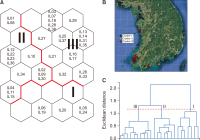


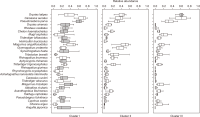


초록
In this study, 4,136 pictures posted on a social media platform were analyzed to discover wetlands that are worth visiting to experience our cultural values. Pictures from 300 of the 2,499 listed wetlands have been posted in South Korea. Proximity of a wetland was the most important criterion, regardless of the type of wetlands that were visited. People visited wetlands at the time and season when they were good for recreational activities. Most of the subjects in the pictures were the visitors and natural scenery of a wetland. There was no correlation observed between the wetland conditions and the number of pictures taken by the visitors. Sightseeing and leisure activities are a significant part of various ecosystem services offered by wetlands, but most of the visitors seem to be unaware that the place they have visited is a wetland. Therefore, wetland awareness programs are needed, even for wetlands close to the residential areas that many people have already visited in this study.
Abstract
In this study, 4,136 pictures posted on a social media platform were analyzed to discover wetlands that are worth visiting to experience our cultural values. Pictures from 300 of the 2,499 listed wetlands have been posted in South Korea. Proximity of a wetland was the most important criterion, regardless of the type of wetlands that were visited. People visited wetlands at the time and season when they were good for recreational activities. Most of the subjects in the pictures were the visitors and natural scenery of a wetland. There was no correlation observed between the wetland conditions and the number of pictures taken by the visitors. Sightseeing and leisure activities are a significant part of various ecosystem services offered by wetlands, but most of the visitors seem to be unaware that the place they have visited is a wetland. Therefore, wetland awareness programs are needed, even for wetlands close to the residential areas that many people have already visited in this study.


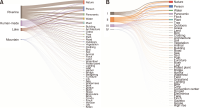

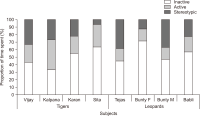
초록
Zoological Parks house exclusive animal species, thus creating a source of education and awareness for visitors. Big cats like tigers and leopards are among the most visited species in zoos globally. However, they often display stressful or stereotypic behaviours. Such behaviours are influenced by multiple factors including visitors, animal history, and captive environment. To understand this impact, we investigated the behavioural response of tigers and leopards to visitation, captive, and biological factors. The behaviour of eight big cats housed in the National Zoological Park, New Delhi, was monitored using focal sampling technique during May and June 2019. We recorded the captive and biological factors and visitor density for the subjects. The study revealed high proportions of inactive and stereotypic behaviours amongst the species. Tigers and leopards were found to perform stereotypic behaviours for 22% and 28% of their time, respectively. Generalised Linear Models revealed a significant variation of stereotypy in association with the factors. Stereotypy was influenced by visitor density, age, sex, breeding history, coat colour, and enclosure design. Adults, males, white-coated, previously bred, and those housed in smaller and simple enclosures display more stereotypy than young, females, normal-coated, unbred, and those housed in larger and complex enclosures, respectively. A high density of visitors induced more stereotypic behaviours amongst the big cats. As providing entertainment and awareness amongst the public is one of the fundamental objectives of the zoo, visitors can not be avoided. Thus, we suggest providing appropriate enrichments that would reduce stereotypies and promote naturalistic behaviours.
Abstract
Zoological Parks house exclusive animal species, thus creating a source of education and awareness for visitors. Big cats like tigers and leopards are among the most visited species in zoos globally. However, they often display stressful or stereotypic behaviours. Such behaviours are influenced by multiple factors including visitors, animal history, and captive environment. To understand this impact, we investigated the behavioural response of tigers and leopards to visitation, captive, and biological factors. The behaviour of eight big cats housed in the National Zoological Park, New Delhi, was monitored using focal sampling technique during May and June 2019. We recorded the captive and biological factors and visitor density for the subjects. The study revealed high proportions of inactive and stereotypic behaviours amongst the species. Tigers and leopards were found to perform stereotypic behaviours for 22% and 28% of their time, respectively. Generalised Linear Models revealed a significant variation of stereotypy in association with the factors. Stereotypy was influenced by visitor density, age, sex, breeding history, coat colour, and enclosure design. Adults, males, white-coated, previously bred, and those housed in smaller and simple enclosures display more stereotypy than young, females, normal-coated, unbred, and those housed in larger and complex enclosures, respectively. A high density of visitors induced more stereotypic behaviours amongst the big cats. As providing entertainment and awareness amongst the public is one of the fundamental objectives of the zoo, visitors can not be avoided. Thus, we suggest providing appropriate enrichments that would reduce stereotypies and promote naturalistic behaviours.

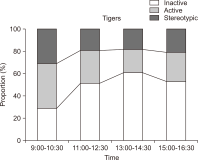


초록
The Yezo sika deer (Cervus nippon yesoensis) is a subspecies of sika deer originated from Hokkaido, Japan. This paper is a study on the ecological impact caused by large mammals invading the ecosystem. Two pairs of deer were donated to the Agency for Defense Development in Taean in the late 1980s, and the population expanded to over 280 in 2018. The thermal imaging camera showed that the population ranged from 8 to 53 herds, divided into approximately 10 groups. It was confirmed that some of the herds had escaped the management area and invaded the nearby natural ecosystem, causing damage to cultivated land and natural vegetation. Herds of over 50 individuals have been studied in large grassland areas near drinking water sources such as streams and ponds. In places with excessive deer concentration, 1) feeding damage to herbs, shrubs and sub-trees, 2) tree withering due to antler-rubbing, and their habit of migrating along forest edges 3) excessive soil loss on slopes, 4) destruction of herbaceous layers due to compaction, and finally 5) damage to infrastructure were also investigated. As such, it is expected that the results of this study on the ecological and economic damage of Yezo sika deer can be used to predict the impact of other exotic sika deer in South Korea with similar behavioral characteristics and to establish a management plan.
Abstract
The Yezo sika deer (Cervus nippon yesoensis) is a subspecies of sika deer originated from Hokkaido, Japan. This paper is a study on the ecological impact caused by large mammals invading the ecosystem. Two pairs of deer were donated to the Agency for Defense Development in Taean in the late 1980s, and the population expanded to over 280 in 2018. The thermal imaging camera showed that the population ranged from 8 to 53 herds, divided into approximately 10 groups. It was confirmed that some of the herds had escaped the management area and invaded the nearby natural ecosystem, causing damage to cultivated land and natural vegetation. Herds of over 50 individuals have been studied in large grassland areas near drinking water sources such as streams and ponds. In places with excessive deer concentration, 1) feeding damage to herbs, shrubs and sub-trees, 2) tree withering due to antler-rubbing, and their habit of migrating along forest edges 3) excessive soil loss on slopes, 4) destruction of herbaceous layers due to compaction, and finally 5) damage to infrastructure were also investigated. As such, it is expected that the results of this study on the ecological and economic damage of Yezo sika deer can be used to predict the impact of other exotic sika deer in South Korea with similar behavioral characteristics and to establish a management plan.


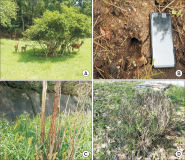
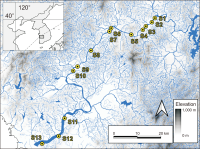
초록
To present the spatial variation of fish assemblages in the Geum River in Korea, the concept of beta diversity (β-diversity) estimates based on the variance of the community data table was applied. Fish communities and environmental variables were collected from 13 sampling sites along the in mid-low reaches of the River. We calculated the β-diversity and local contribution to beta diversity (LCBD) values at each site depending on the two types of data, ‘occurrence’ with Jaccard and Sørensen dissimilarity coefficients, and ‘abundance’ with Hellinger distance. Multivariate and correlation analyses were also performed to determine the relationships between LCBD and other variables, such as community indices and physicochemical and hydrological factors. The β-diversity values of fish communities in the River were estimated as 0.218 and 0.145 for occurrence data table with Jaccard and Sørensen respectively, and 0.268 for abundance data. Similar patterns of LCBD along the sampling sites were detected in two dissimilarity measurements of occurrence table, and LCBD values with abundance data were slightly different. The LCBD values are strongly correlated with community indices, and also suitable for indicating the uniqueness of fish assemblages. However, further research is needed to determine the LCBD value as an indicator of environmental variability.
Abstract
To present the spatial variation of fish assemblages in the Geum River in Korea, the concept of beta diversity (β-diversity) estimates based on the variance of the community data table was applied. Fish communities and environmental variables were collected from 13 sampling sites along the in mid-low reaches of the River. We calculated the β-diversity and local contribution to beta diversity (LCBD) values at each site depending on the two types of data, ‘occurrence’ with Jaccard and Sørensen dissimilarity coefficients, and ‘abundance’ with Hellinger distance. Multivariate and correlation analyses were also performed to determine the relationships between LCBD and other variables, such as community indices and physicochemical and hydrological factors. The β-diversity values of fish communities in the River were estimated as 0.218 and 0.145 for occurrence data table with Jaccard and Sørensen respectively, and 0.268 for abundance data. Similar patterns of LCBD along the sampling sites were detected in two dissimilarity measurements of occurrence table, and LCBD values with abundance data were slightly different. The LCBD values are strongly correlated with community indices, and also suitable for indicating the uniqueness of fish assemblages. However, further research is needed to determine the LCBD value as an indicator of environmental variability.



_학술지_디자인_시안_koar_top_300x55.png)
